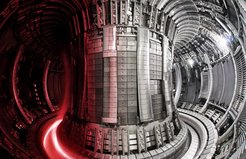New experiments for ITER preparation at the fusion facility JET
European researchers are using helium plasmas to test the interaction with the wall material of the Joint European Torus (JET). The Max Planck Institute for Plasma Physics is also involved.

In February, the Joint European Torus (JET) fusion experiment in Culham, UK, made headlines with a world record: for the first time, an amount of energy of 59 megajoules could be generated in a fusion plasma - an important milestone on the way to a future fusion power plant. Now researchers from the European EUROfusion programme have started new groundbreaking experiments at JET. In September, they began tests with helium plasmas that should shed light on the future operation of ITER - the fusion megaproject under construction in southern France. ITER is to generate ten times more energy with deuterium-tritium plasmas than needs to be fed in as heating energy. Once completed, however, the plant will probably initially work with helium and hydrogen test plasmas, which are easier to handle than deuterium-tritium mixtures.
"With the current experiments, we want to learn more about the operation of helium plasmas in large fusion facilities and investigate how our present understanding of the physics translates to different gases," explains Dr Philip Schneider from the Max Planck Institute for Plasma Physics (IPP). Together with other IPP researchers, he is part of the European team conducting experiments with helium at JET and other tokamaks such as ASDEX Upgrade at IPP.
“We have great expectations for how these experiments can help us optimise our plan to move as efficiently as possible into deuterium-tritium operation,” says Dr Tim Luce, Head of Science and Operation at ITER.
The helium experiments at JET are scheduled for a period of up to 16 weeks.
